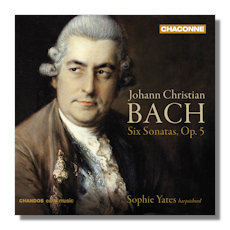
The Internet's Premier Classical Music Source
Related Links
- J.C. Bach Reviews
- Latest Reviews
- More Reviews
-
By Composer
-
Collections
DVD & Blu-ray
Books
Concert Reviews
Articles/Interviews
Software
Audio
Search Amazon
Recommended Links
Site News
 CD Review
CD Review
Johann Christian Bach

Six Sonatas Op. 5 (1766)
- Sonata #1 in B Flat Major (W: A1)
- Sonata #2 in D Major (W: A2)
- Sonata #3 in G Major (W: A3)
- Sonata #4 in E Flat Major (W: A4)
- Sonata #5 in E Major (W: A5)
- Sonata #6 in C minor (W: A1)
Sophie Yates, harpsichord
Chandos Chaconne CHAN0762
Johann Christian Bach (1735-1782) is sometimes referred to as the "London" (or "English") Bach because of the time he spent in the English capital city. The eleventh and youngest son of J.S. Bach, he studied with his father and Carl Philipp Emanuel; then with Padre Martini in Bologna on Johann Christian's move to Italy in 1756, where – four years later – the composer became organist at Milan cathedral. While in Italy he converted from Lutheranism to Catholicism, too. In London with his compatriot Karl Friedrich Abel (1723-1787), J.C. Bach established the first subscription concerts; their huge success led to the modern public concert as we know it. Such a cosmopolitan life must in part account for the urbanity of and breadth of vision in his music.
Suffering from unfavorable comparisons with his father during the early years of his music's reception, J.C. Bach has recently undergone a measure of reassessment. His music is now considered legitimate in its own right and "self-standing". This is a tenable view when it's remembered that J.C. Bach never consciously tried to imitate his father's music: he was at home writing in the galant style with its emphasis on balance, melody and accompaniment, rather than counterpoint; graceful melody in fluid phrasing was more important than the complexities of the Baroque. Such a dignified and translucent approach (and one which is completely at ease with its own limits and with contemporary taste) is the approach taken on this welcome recording by British original instrument performer Sophie Yates.
Playing an unidentified harpsichord (at least in the otherwise informative booklet that comes with this CD), Yates has poise and passion in equal measure. At first, you may be tempted to respond chiefly to "charm" and delicacy in the way she slowly and with great technique and care exposes these six keyboard sonatas. That would be deceptive; or at least barely half the story. For there's really so much more to the music than this: structure, surprise, intricate changes of key and texture (about-turns, almost, at some points). Yates' performance is built on an awareness, a celebration, of this at times almost Italianate complexity… and an acknowledgement of earlier Italian vocal music, at that.
Yates explains in her essay in the booklet that, although some of these features of the music were ideally suited to the pianoforte, and although Bach sanctioned their performance on either instrument, she prefers the harpsichord because it privileges the "freshness" of the music. That is a keystone of this CD: these six sonatas, every one (indeed, every movement) is different; nor are they miniatures waiting for Mozart or fleeing Haydn. They are sophisticated explorations of a variety of original and sustained temperaments and colors.
Indeed, there is an expansiveness in Yates' playing that reflects the increase in the popularity of this type of work that was common in eighteenth century London, in the resources consequently devoted to their performance, in their appreciation by growing audiences, and thus in a general musical momentum. For example, melancholy (as in the third Sonata's allegretto [tr.7]) is… well, "toyed with". Bach is looking outside the idiom to elaborate on it – almost for theatrical purposes. Yates is in total accord with how Bach expected us to receive his manipulations (perhaps "management" would be a better term) of our expectations. At the same time, she is able to infuse her own personality confident that Bach would have understood her unique and intimate relationship between work and performer. In other words, although Yates as performer is always, rightly, secondary to Bach as composer, she has succeeded well in interpreting him to us over a very broad, deep and sympathetic range of ways. Admirable. Particularly successful is Yates' handling of J.C. Bach's matching of backward- and forward-looking style, as in the C minor Sixth Sonata. Significantly, she has perhaps approached this in such a way as to invite us to see J.C. Bach in a more nuanced way; ideally, more accurately and appreciatively too.
There is only one other viable recording of these fine sonatas available: that on Caro Mitis SACD CM0052004 by Olga Martynova. Interestingly, that SACD shares with this by Yates on Chandos a particular attention to recording and sound quality… the Chandos uses its 24-bit recording technology, which has a dynamic range up to 48 dB greater than the average 16-bit techniques, and up to 256 times the resolution. There is certainly great clarity and depth in the Yates' sound. Every nuance of the flood of notes in the E Major (Op. 5) allegro [tr.10], for instance, is audible; as though every component of every note had a life in its own right. This is thus a recording of these elegant and touching sonatas that can be unhesitatingly recommended. Not only does Yates more than do justice to the compositions; she does so with style, commitment and a gentle latitude that render J.C. Bach's works both accessible and challenging.
Copyright © 2009, Mark Sealey




















